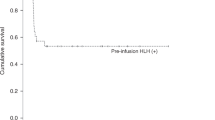Abstract
A 36-year-old man was admitted because of numbness and muscle weakness in the lower extremities. He had gait disturbance, malaise, and body weight loss. Based on the existence of monoclonal gammopathy, the proliferation of abnormal plasma cells in the bone marrow, the presence of sclerotic bone lesion, polycythemia, mild splenomegaly, and an elevated level of serum vascular endothelial growth factor (VEGF) (14,900 pg/mL; normal, 62-707), he was diagnosed as having peripheral neuropathy, organomegaly, endocrinopathy, monoclonal gammopathy, and skin changes (POEMS) syndrome. Following 2 courses of conventional chemotherapy with doxorubicin and dexamethasone, peripheral blood stem cells were mobilized by high-dose etoposide (500 mg/m2 X 3 days) and granulocyte colony-stimulating factor. After purging by CD34+ selection using the CliniMACS device, the selected cells (12.4 X 106/kg) were cryopreserved. He was then treated with tandem high-dose chemotherapy (HDC) (melphalan 100 mg/m2 X 2 days) with autologous stem cell rescue. After the first course of HDC, the serum level of VEGF normalized and the minimal residual disease in the bone marrow was reduced below the detection limit of CDR3 analysis by polymerase chain reaction. The patient has been in remission for more than 20 months. He has gradually recovered from the neurological symptoms and now has no impairments of daily living. Our experience suggests that autologous purged stem cell transplantation should be considered as the treatment of choice for POEMS syndrome.
Similar content being viewed by others
References
Nakanishi T, Sobue I, Toyokura Y, et al. The Crow-Fukase syndrome: a study of 102 cases in Japan. Neurology. 1984;34:712–720.
Dispenzieri A, Kyle RA, Lacy MQ, et al. POEMS syndrome: definitions and long-term outcome. Blood. 2003;101:2496–2506.
Watanabe O, Maruyama I, Arimura K, et al. Overproduction of vascular endothelial growth factor/vascular permeability factor is causative in Crow-Fukase (POEMS) syndrome. Muscle Nerve. 1998;21:1390–1397.
Hashiguchi T,Arimura K, Matsumuro K, et al. Highly concentrated vascular endothelial growth factor in platelets in Crow-Fukase syndrome. Muscle Nerve. 2000;23:1051–1056.
Scarlato M, Previtali SC, Carpo M, et al. Polyneuropathy in POEMS syndrome: role of angiogenic factors in the pathogenesis. Brain. 2005;128:1911–1920.
Soubrier M, Dubost JJ, Serre AF, et al. Growth factors in POEMS syndrome: evidence for a marked increase in circulating vascular endothelial growth factor. Arthritis Rheum. 1997;40:786–787.
Kuwabara S, Misawa S, Kanai K, et al. Autologous peripheral blood stem cell transplantation for POEMS syndrome. Neurology. 2006;66:105–107.
Soubrier M, Ruivard M, Dubost JJ, Sauvezie B, Philippe P. Successful use of autologous bone marrow transplantation in treating a patient with POEMS syndrome. Bone Marrow Transplant. 2002;30:61–62.
Peggs KS, Paneesha S, Kottaridis PD, et al. Peripheral blood stem cell transplantation for POEMS syndrome. Bone Marrow Transplant. 2002;30:401–404.
Jaccard A, Royer B, Bordessoule D, Brouet JC, Fermand JP. High-dose therapy and autologous blood stem cell transplantation in POEMS syndrome. Blood. 2002;99:3057–3059.
Rovira M, Carreras E, Blade J, et al. Dramatic improvement of POEMS syndrome following autologous haematopoietic cell transplantation. Br J Haematol. 2001;115:373–375.
Attal M, Harousseau JL, Facon T, et al. Single versus double autologous stem-cell transplantation for multiple myeloma. N Engl J Med. 2003;349:2495–2502.
Trainor KJ, Brisco MJ, WanGene JH, et al. Gene rearrangement in B- and T-lymphoproliferative disease detected by the polymerase chain reaction. Blood. 1991;78:192–196.
Imai Y, Chou T, Tobinai K, et al. Isolation and transplantation of highly purified autologous peripheral CD34+ progenitor cells: purging efficacy, hematopoietic reconstitution in non-Hodgkin’s lymphoma (NHL): results of Japanese phase II study. Bone Marrow Transplant. 2005;35:479–487.
Damiani D, Stocchi R, Masolini P, et al. CD34+-selected versus unmanipulated autologous stem cell transplantation in multiple myeloma: impact on dendritic and immune recovery and on complications due to infection. Ann Oncol. 2003;14:475–480.
Frere P, Pereira M, Fillet G, Beguin Y. Infections after CD34-selected or unmanipulated autologous hematopoietic stem cell transplantation. Eur J Haematol. 2006;76:102–108.
Stewart AK, Vescio R, Schiller G, et al. Purging of autologous peripheral-blood stem cells using CD34 selection does not improve overall or progression-free survival after high-dose chemotherapy for multiple myeloma: results of a multicenter randomized controlled trial. J Clin Oncol. 2001;19:3771–3779.
Galimberti S, Morabito F, Guerrini F, et al. Peripheral blood stem cell contamination evaluated by a highly sensitive molecular method fails to predict outcome of autotransplanted multiple myeloma patients. Br J Haematol. 2003;120:405–412.
Vogel W, Kopp HG, Kanz L, Einsele H. Myeloma cell contamination of peripheral blood stem-cell grafts can predict the outcome in multiple myeloma patients after high-dose chemotherapy and autologous stem-cell transplantation. J Cancer Res Clin Oncol. 2005;131:214–218.
Lemoli RM, Martinelli G, Zamagni E, et al. Engraftment, clinical, and molecular follow-up of patients with multiple myeloma who were reinfused with highly purified CD34+ cells to support single or tandem high-dose chemotherapy. Blood. 2000;95:2234–2239.
Vital C,Vital A, Ferrer X, et al. Crow-Fukase (POEMS) syndrome: a study of peripheral nerve biopsy in five new cases. J Peripher Nerv Syst. 2003;8:136–144.
Author information
Authors and Affiliations
Corresponding author
About this article
Cite this article
Kojima, H., Katsuoka, Y., Katsura, Y. et al. Successful Treatment of a Patient with POEMS Syndrome by Tandem High-Dose Chemotherapy with Autologous CD34+ Purged Stem Cell Rescue. Int J Hematol 84, 182–185 (2006). https://doi.org/10.1532/IJH97.06067
Received:
Revised:
Accepted:
Published:
Issue Date:
DOI: https://doi.org/10.1532/IJH97.06067




